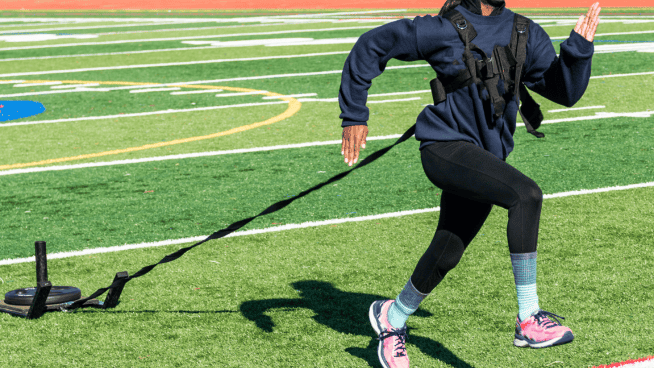1 Set, 20 Reps: The Strange Workout Strategy That Gets Results
There are many unanswered questions in the field of strength and conditioning.
Where should inexperienced athletes start with weight training? How should athletes train after their competitive season is over?
The 1×20 system by Dr. Michael Yessis, a famed sports performance trainer who’s specialized in adapting and implementing training methods from the former Soviet Union, sheds light on what could be a fantastic option for these types of athletes.
After reading Dr. Yessis’s book, The Revolutionary 1 x 20 RM Strength Training Program, I’ve become convinced that a 1×20 set/rep scheme actually has some real merit in the world of athletic performance.
Yes, that means performing just one set of a given exercise, but that set contains 20 reps. Most people with any training experience are accustomed to 3×10, 5×5, etc., so the idea of a 1×20 workout sounds completely ridiculous. But the logic and the results are sound. Let’s run through a few major reasons why a 1×20 might offer legit benefit compared to other, more traditional rep schemes.
The untrained body adapts faster to lower-intensity training and does so with a lower risk of injury. In young athletes who may just be starting out in resistance training, excessive soreness and high fatigue (potential causes of injury) can be greatly minimized with a 1×20 scheme compared to more traditional set/rep methods. This is due to both the lower total number of reps being performed as well as the lighter load that must be utilized to achieve 20 unbroken reps. Now, this doesn’t mean you want to choose a weight that you could do 40 reps with. You still want to pick a weight you find challenging-yet-manageable to get those 20 reps.
This training allows for a gradual buildup of intensity instead of “shocking” these athletes with high-intensity training too soon. For more advanced athletes who are just coming off their competitive season, a 1×20 scheme allows them to begin rebuilding their body without compromising their recovery.
But can it get results? Yes!
For athletes who’re just starting a lifting program (or who are starting a program again after a long lay-off), multiple sets are not needed to see adaptation and results. Whenever a new exercise or lifting program is started, the body adapts to very little volume. Novel stimuli signal adaptations with not much training at all. For this reason, young athletes and early offseason athletes do not need to perform multiple sets of exercises. These groups will adapt and get stronger with just one set taken close to failure.
More total exercises can be managed because only one set is being performed of each. This allows the athlete to cover more movements and joint actions. This is especially important for athletes who’re just starting out in resistance training. To cover most basic human movements (squat, hinge, horizontal/vertical push, horizontal/vertical pull, rotation, actions of locomotion, etc.) many different exercises need to be performed. The 1×20 system allows athletes to perform all of these movements in one session, because each exercise takes only a minute or two.
1×20 involves high blood flow which increases muscular endurance and strengthens ligaments and tendons. For athletes to perform high intensity strength training, a foundation of muscular endurance should already exist. This allows for faster removal of muscle metabolites so the working muscle can recover. For young and early offseason athletes, this foundation, as well as a basis of strong and thick tendons and ligaments, is necessary to avoid injury and handle higher intensity training.
Youth and offseason athletic development takes time. Athletes shouldn’t just hop in to high-intensity training on Day 1. A gradual buildup of volume and intensity allows for consistent adaptation with minimal chance for injury. “The quicker you gain strength the faster, you will lose it. The slower you gain strength, the longer you will keep it.” -Dr. Michael Yessis.
If this has peaked your interest, check out my free PDF that contains a full 1×20 Method Training Program.
Photo Credit: nd3000/iStock
RECOMMENDED FOR YOU
MOST POPULAR
1 Set, 20 Reps: The Strange Workout Strategy That Gets Results
There are many unanswered questions in the field of strength and conditioning.
Where should inexperienced athletes start with weight training? How should athletes train after their competitive season is over?
The 1×20 system by Dr. Michael Yessis, a famed sports performance trainer who’s specialized in adapting and implementing training methods from the former Soviet Union, sheds light on what could be a fantastic option for these types of athletes.
After reading Dr. Yessis’s book, The Revolutionary 1 x 20 RM Strength Training Program, I’ve become convinced that a 1×20 set/rep scheme actually has some real merit in the world of athletic performance.
Yes, that means performing just one set of a given exercise, but that set contains 20 reps. Most people with any training experience are accustomed to 3×10, 5×5, etc., so the idea of a 1×20 workout sounds completely ridiculous. But the logic and the results are sound. Let’s run through a few major reasons why a 1×20 might offer legit benefit compared to other, more traditional rep schemes.
The untrained body adapts faster to lower-intensity training and does so with a lower risk of injury. In young athletes who may just be starting out in resistance training, excessive soreness and high fatigue (potential causes of injury) can be greatly minimized with a 1×20 scheme compared to more traditional set/rep methods. This is due to both the lower total number of reps being performed as well as the lighter load that must be utilized to achieve 20 unbroken reps. Now, this doesn’t mean you want to choose a weight that you could do 40 reps with. You still want to pick a weight you find challenging-yet-manageable to get those 20 reps.
This training allows for a gradual buildup of intensity instead of “shocking” these athletes with high-intensity training too soon. For more advanced athletes who are just coming off their competitive season, a 1×20 scheme allows them to begin rebuilding their body without compromising their recovery.
But can it get results? Yes!
For athletes who’re just starting a lifting program (or who are starting a program again after a long lay-off), multiple sets are not needed to see adaptation and results. Whenever a new exercise or lifting program is started, the body adapts to very little volume. Novel stimuli signal adaptations with not much training at all. For this reason, young athletes and early offseason athletes do not need to perform multiple sets of exercises. These groups will adapt and get stronger with just one set taken close to failure.
More total exercises can be managed because only one set is being performed of each. This allows the athlete to cover more movements and joint actions. This is especially important for athletes who’re just starting out in resistance training. To cover most basic human movements (squat, hinge, horizontal/vertical push, horizontal/vertical pull, rotation, actions of locomotion, etc.) many different exercises need to be performed. The 1×20 system allows athletes to perform all of these movements in one session, because each exercise takes only a minute or two.
1×20 involves high blood flow which increases muscular endurance and strengthens ligaments and tendons. For athletes to perform high intensity strength training, a foundation of muscular endurance should already exist. This allows for faster removal of muscle metabolites so the working muscle can recover. For young and early offseason athletes, this foundation, as well as a basis of strong and thick tendons and ligaments, is necessary to avoid injury and handle higher intensity training.
Youth and offseason athletic development takes time. Athletes shouldn’t just hop in to high-intensity training on Day 1. A gradual buildup of volume and intensity allows for consistent adaptation with minimal chance for injury. “The quicker you gain strength the faster, you will lose it. The slower you gain strength, the longer you will keep it.” -Dr. Michael Yessis.
If this has peaked your interest, check out my free PDF that contains a full 1×20 Method Training Program.
Photo Credit: nd3000/iStock










